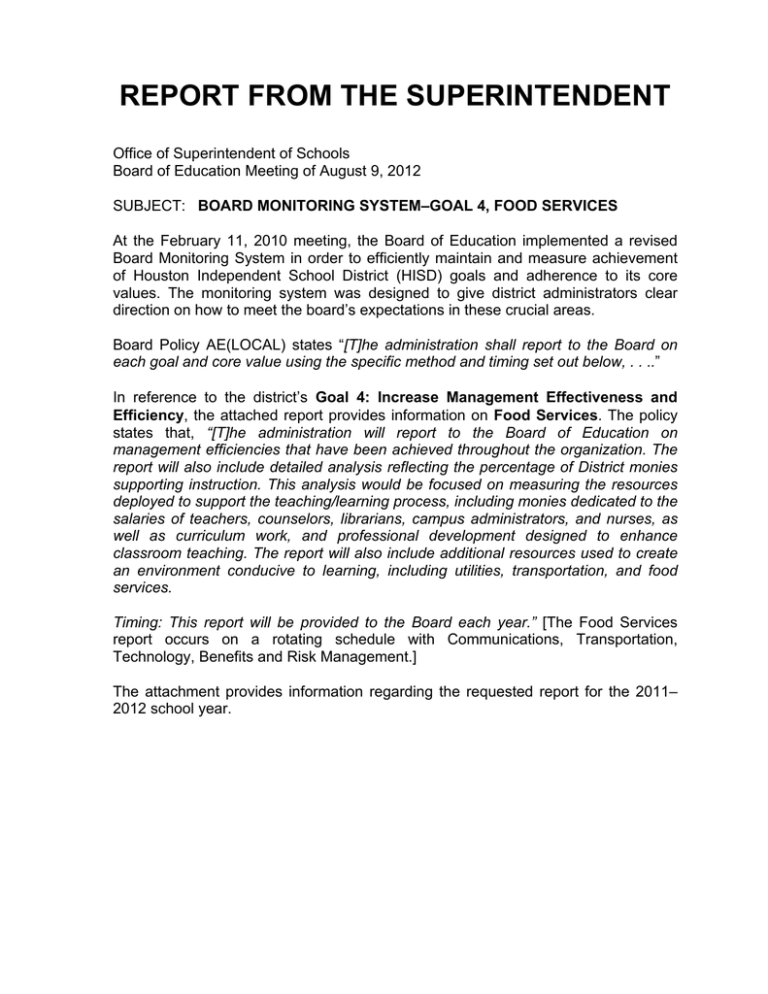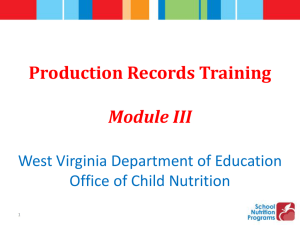REPORT FROM THE SUPERINTENDENT
advertisement

REPORT FROM THE SUPERINTENDENT Office of Superintendent of Schools Board of Education Meeting of August 9, 2012 SUBJECT: BOARD MONITORING SYSTEM–GOAL 4, FOOD SERVICES At the February 11, 2010 meeting, the Board of Education implemented a revised Board Monitoring System in order to efficiently maintain and measure achievement of Houston Independent School District (HISD) goals and adherence to its core values. The monitoring system was designed to give district administrators clear direction on how to meet the board’s expectations in these crucial areas. Board Policy AE(LOCAL) states “[T]he administration shall report to the Board on each goal and core value using the specific method and timing set out below, . . ..” In reference to the district’s Goal 4: Increase Management Effectiveness and Efficiency, the attached report provides information on Food Services. The policy states that, “[T]he administration will report to the Board of Education on management efficiencies that have been achieved throughout the organization. The report will also include detailed analysis reflecting the percentage of District monies supporting instruction. This analysis would be focused on measuring the resources deployed to support the teaching/learning process, including monies dedicated to the salaries of teachers, counselors, librarians, campus administrators, and nurses, as well as curriculum work, and professional development designed to enhance classroom teaching. The report will also include additional resources used to create an environment conducive to learning, including utilities, transportation, and food services. Timing: This report will be provided to the Board each year.” [The Food Services report occurs on a rotating schedule with Communications, Transportation, Technology, Benefits and Risk Management.] The attachment provides information regarding the requested report for the 2011– 2012 school year. Board Monitoring System: Goal 4 DEPARTMENT SUMMARY As part of the Houston Independent School District (HISD) Board Monitoring System, the HISD Board of Education has requested periodic reviews of administrative systems within the district. Therefore, in lieu of the monthly A-1 Status Report, Food Services has provided this department overview including the following: 1. Department Goals and Nutrition Mission Statement ................................... 2 2. Areas of Responsibility ................................................................................ 2 3. Provided Services ....................................................................................... 2 4. Fast Facts / Scope of Services.................................................................... 3 5. 2011–2012 Key Accomplishments .............................................................. 3 - 5 6. 2012–2013 Major Initiatives ........................................................................ 5 - 6 7. Program Evaluations and Audits ................................................................. 6 8. Figure 1: Organizational Charts ................................................................. 7 9. Figure 2: Schedule of Revenues, Expenditures, and changes in Fund Net Assets................................................................. 8 10. Figure 3 and 4: Breakfast and Lunch Meal Participation Comparisons .... 9 August 2012 1 Summary Overview 1. Food Services Goals and Nutrition Mission Statement The goals for Food Services are as follows: increase student participation in all programs identify every eligible child for free or reduced-price meals provide employee training and a safe environment increase customer satisfaction earn recognition as a national leader in child nutrition and wellness among public school districts Food Services’ Nutrition Mission: "Houston ISD will be a leader in child nutrition and wellness by providing the highest level of nutrition possible on our campuses, by providing comprehensive nutrition and wellness education, and by engaging the entire HISD community to teach our children the benefits of making healthy choices." 2. Areas of Responsibility Human Resources Information Technology – Automated Data Collection, SAP systems, Cybersoft Point-of-Sale and Production planning, PeopleSoft integration Student Eligibility and Accountability – Free and Reduced-price meal applications Finance Communications/Marketing Operations – Campus-based Production – Culinary, Nutrition Services, Production Areas of the Food Services Support Facility (FSSF) Warehouse and Distribution Maintenance – Campus Kitchens and Food Service Support Facility (FSSF) Quality Assurance (FSSF quality and food safety) Quality Control (campus based food and kitchen safety, compliance reviews) 3. Services Provided • Breakfast – Traditional Cafeteria Service and First Class Breakfast – 13 Million meals • Lunch Program – 23 Million meals • Summer Meals Program - 1.8 Million meals • After-school Snacks • Saturday Tutorial Meals • Full Service Catering • Nutrition and Wellness Awareness - Dietetic Intern Program, Student and Parent Wellness Engagement Committees - Mobile Dairy Cow Show, Student Tours, Nutrition Mascot, Harvest of the Month, Garden Connection, Build-a-Healthy-Meal Menus 4. Fast Facts/Scope of Services • Total Employees – 1,898 August 2012 2 • • • • • • • - Management, Grade 25 and above – 49 (See Figure 1.) - Production, Administration, Maintenance, Warehouse/Transportation – 239 - Field Employees – Team Leads and Food Service Attendants – 1,587 19 ARAMARK salaried positions, 3 hourly positions 284 buildings/kitchens 262,890 meals served per day (YTD May 2012) 80.8 percent of enrollment eligible for free or reduced meal status A la carte revenue $32,000 per day Food Services Production Facility: • 15 acres • 219,000 sq. ft. • 32 shipping and receiving docks • Estimated annual meal capacity of 52 million meals 2011–2012 Budget $111.7 Million budget $56.6 million supplies and materials $41.6 million payroll $13.5 million direct costs and utilities 5. 2011–2012 Key Accomplishments Operations: • First Class Breakfast o Developed and implemented a new cost-saving service style for the First Class Breakfast (FCB) program called “Offer versus Serve.” The new service model offers students a daily multi-selection of entrees, fruits, and beverage choices as opposed to requiring students to take the one entrée or side and milk which was previously offered under a “straight serve” service model. This allows students to choose what they like and reduces overall food waste. The program was implemented in 93 of the 214 campuses serving breakfast in the classroom, resulting in a 2 percent increase in participation and a significant decrease in food cost at those campuses. o A breakfast study conducted by HISD Research and Accountability was published in April 2012 based on data collected over the first two years of program implementation. The following conclusions were reported: - Compared to pre-implementation levels in HISD elementary schools, implementation of the FCB program was associated with significant increases in attendance rates, decreases in disciplinary actions, and increases in TAKS mathematics passing rates. - Implementation of the FCB program in HISD middle schools was related to increases in attendance rates and TAKS mathematics passing rates. - Currently, 214 schools participate in the FCB program. The food services staff members and district administration continue to encourage the remaining campuses (predominately high schools) to implement similar programs. Providing a healthy breakfast to as many students as possible will help strengthen the district’s academic initiatives and support overall student learning. August 2012 3 • • • • • • Food Services operations and culinary leadership continued monthly engagement with the Food Services Parent Advisory Committee. Program feedback and parent perspective has encouraged steady focus on menus that target optimal nutritional health and encouraged the expansion of the First Class Breakfast program. The entire Food Services department incorporated compliance focus in all training activities leading to the finalization of the United States Department of Agriculture/Texas Department of Agriculture (USDA/TDA) Coordinated Review Effort (major program compliance audit) with no financial penalties to Food Services. Campus staffing levels were effectively managed to meet the established goal of 27 meals per labor hour and hold associated labor costs to $2M less than prior year. ARAMARK Education invested $200,000 to implement 21 new service line renovations in a total of eight high school cafeterias. The investment was successful in driving meal participation and featured ARAMARK’s popular “build your own” dining concepts Green Street Deli and Tortilla Fresh Mex. Additionally, six other elementary and middle school campuses received serving area makeovers. An aggressive promotional campaign was designed to drive participation and launched to counteract the typical lower meal participation levels of the spring months. A robust employee recognition program and multiple employee activities were implemented to increase employee appreciation and engagement. Support Services: • Established new Production Scheduling and Schedule Attainment Tool to measure labor utilization and variances from plans and to target waste reduction opportunities. • Coordinated cross-functional training for team leads and supervisors at the FSSF in order to strengthen leadership across different production areas and processes. • Attained $160,000 favorable variance to the standard material cost for FSSF produced foods over the year. Significant improvement to last year’s $250,000 unfavorable variance. • Redesigned the inventory process to improve the accuracy of production reporting and inventory control. • Warehousing achieved over 100 “picks per labor hour” productivity rate in the warehouse for the last 4 months of the year, beating last year’s average rate of 89.9 “picks per labor hour.” • Constant focus on details allowed for the warehouse Order Fill Rate to improve to 98 percent. Order Fill Rate is measured as a ratio of correct product shipped versus the original kitchen order. • Initiated Daily Cycle Counting in the warehouse to improve inventory accuracy. Endof-year inventory variance for the year was favorable $12,000 in 2012 versus unfavorable $118,000 previous year. • Implemented SAP’s Shelf Life, Expiration Date (SLED) functionality to enhance management of inventory aging and quality. • Food Services Maintenance team sustained quick response time for high priority Level One and Two work orders, ensuring kitchen equipment was properly maintained throughout the year with no loss of service days. August 2012 4 • • • • • • Completed more maintenance work orders in 2011–2012, even with a reduced budget. Redesigned menus and menu options to reduce food cost beginning in November 2011, resulting in significant contribution to the end-of-year financial results. Developed new menu “pre-cost” tool to assist with menu design and more accurate cost projections across multiple menus. Supported an increase in special diet needs throughout the district. More than 300 safety training classes were facilitated for FSSF employees. Implemented new “safety incident tracker” to capture incident data, in addition to focused root cause analysis, to reduce the number of incident occurrences. 6. 2012–2013 Major Initiatives Operations • Reorganize operations department leadership to afford more support, accountability, and training opportunities for campus staff members. • Revitalize participation drive for free and reduced-price meal applications utilizing “Meal Sense,” Food Service’s multi-level community outreach campaign promoting on-line applications and 100 percent application return. • Continue the implementation of Offer versus Serve First Class Breakfast to a targeted 90 percent of participating campuses. • Focus on food safety compliance training and accountability. • Provide focused training for campus kitchen personnel and an extensive community education effort regarding new USDA nutrition requirements. • Increase focus on parent and student nutrition education. • Introduce fresh fruit and vegetable stations (i.e. salad bars) at a minimum of eight additional pilot campuses. Closely monitor pilot campuses for associated costs, product availability, food waste, and meal participation levels. • High School dining concept expansions scheduled for 88 service lines in 31 campuses throughout the district. These build-your-own concepts include expanding the new Green Street Deli and Tortilla-Fresh Mex stations to most campuses and introducing a new build-your-own grill line and a comfort food station. • Enhance employee recognition and engagement program Support Services • Full implementation of SAP’s MRP functionality with respect to manufacturing designs, systems, and operations. • Expand functionality of CATAMARAN hand-held technology to improve warehouse productivity and food production reporting and transaction accuracy. • Install dock levelers to reduce maintenance and repair costs associated with improper dock door designs. • Reinvest in the Food Service Support Facility by installing new equipment in order to produce hamburger/hot dog buns and properly wash and cut fresh fruits and vegetables in quantities needed to serve 260,000 meals daily. • Continue improving safety culture and training. August 2012 5 • Create Culinary Training Academy – A two-week program where operation managers and cafeteria team leads will have professional training in culinary skills, food preparation, line presentation, and customer service. 7. Program Evaluations and Audits • • • • USDA/TDA Coordinated Review Effort - Review was performed in January 2012. The review indicated no financial penalties for Food Services. TDA Summer Food Service Program Administrative Review - Reviews were performed in 2010, 2011 and 2012. HISD passed consecutively without corrective action needed or financial penalties. Results of the recently completed 2012 review are still pending; however, no indication of corrective action cited in exit interview. ARAMARK Financial Audits – Results from audits performed in 2010, 2011, and 2012 confirm no major violations. City of Houston Health Department Inspections – Required minimum of two city health inspections were performed per campus in 2011 and 2012. List of Figures on following pages: Figure 1 – Organization Chart Figure 2 – Schedule of Revenues and Expenditures/Fund Balance Figure 3 – Breakfast Meal Participation Year Over Year Comparison Figure 4 – Lunch Meal Participation Year Over Year Comparison August 2012 6 Figure 1 August 2012 7 Figure 2 HOUSTON INDEPENDENT SCHOOL DISTRICT FOOD SERVICE FUND FOR THE FISCAL YEAR ENDED JUNE 30, 2012 (PROJECTED), WITH COMPARATIVE DATA FOR PRIOR YEARS AND 2013 BUDGET 2009-2010 Actual 2010-2011 Actual 2011-2012 Projection 2012-2013 Budget $10,632,279 3,076 $9,645,209 4,758 $10,327,944 2,064 $9,684,018 1,912 937,992 590,245 762,895 594,190 797,712 621,963 807,011 594,191 83,251,515 6,106,843 10,604,609 112,126,559 96,343,764 6,056,919 0 113,407,735 94,103,131 5,495,082 0 111,347,896 96,826,335 5,294,334 0 113,207,801 101,216,988 713,826 109,066,502 907,092 90,441,109 8,644,516 96,481,054 8,487,805 5,459,059 107,389,873 5,090,312 115,063,906 7,804,076 106,889,701 8,023,865 112,992,724 4,736,686 (1,656,171) 4,458,195 215,077 746,616 5,483,302 3,827,131 8,285,326 $5,483,302 $3,827,131 $8,285,326 $8,500,403 REVENUES Food Sales Interest Income Miscellaneous Local Sources State Matching Funds Child Nutrition Programs/Summer Food Program Donated Commodities Other Sources Total Revenues EXPENSES Current Food Services General Administration Plant Maintenance and Operations Total Expenses Change in Fund Net Assets Total Net Assets Beginning Total Net Assets - Ending August 2012 8 Figure 3 Breakfast Participation Rate 60% 58% 56% 54% 52% 50% 48% 46% 44% AUG SEP OCT NOV DEC JAN FEB MAR APR MAY 2010‐2011 50% 53% 56% 58% 59% 57% 56% 57% 56% 55% 2011‐2012 50% 55% 58% 58% 58% 57% 57% 57% 57% 56% Figure 4 Lunch Participation Rate 74% 72% 70% 68% 66% 64% 62% 60% 58% 56% 54% AUG SEP OCT NOV DEC JAN FEB MAR APR MAY 2010‐2011 65% 66% 66% 68% 71% 70% 69% 70% 72% 69% 2011‐2012 60% 64% 66% 67% 68% 67% 68% 68% 68% 67% August 2012 9




